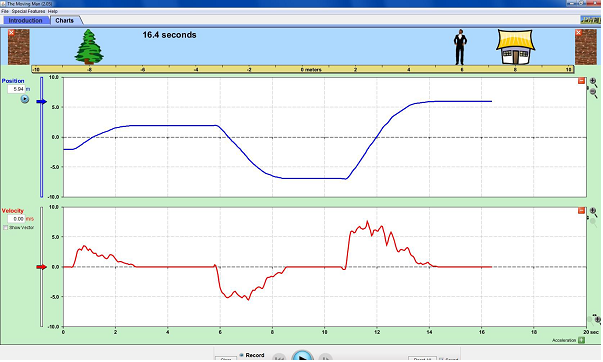Problem 1

Describe, in detail, the motion of the man as represented in the graphs. You might find it useful to visit the website and play with the simulation to get a feel for what is going on,
In your description give a start and end time for each part of the motion.
Give the overall displacement of the man and the total distance he has travelled.
Problem 2
a) Evel Knievel became famous for jumping over things on a motorbike. On March 25 1967 he did his first jump for a TV sports channel and managed to clear 15 cars (90 feet). Assuming his take-off angle was 45 degrees and air resistance was negligible (which it is not) what would his velocity (m/s) have to be just before he left the take-off ramp?
b) On May 31, 1975 he performed his last jump at Wembley Stadium UK. He attempted to jump over 13 busses and had to reach 90 miles per hour at the take-off to do this. Unfortunately the take-off ramp was not long enough for him to achieve this and he landed "just shy" of the landing ramp breaking his pelvis again. The big red London busses were 2.43m wide. If he had been able to reach his desired speed what would his maximum height above the busses have been if you could ignore air resistance?
c) It is not possible to ignore air resistance. Compare the distance he wanted to cover in the real world with the "theoretical" distance that could be covered if there was no air resistance.
Problem 3
In my younger days I did a little abseiling down the side of the school to demonstrate forces in equilibrium for my physics students. At one point in the decent I would stop in a position similar to the person in the picture in the link below. Draw a free-body force diagram of the forces acting on this person.
Assume this person has a mass of 72kg, they are half way down a 12m wall with the rope secured at the top of the wall. What is the magnitude of the force between their feet and the wall? What is the tension in the rope?
Problem 4
On a spring day (temperature 20 C) a Toyota Prius (hybrid) is driving at the speed limit along the freeway. It has a drag coefficient of 0.25 what drag force is it experiencing? How much energy would be used in overcoming air resistance during the drive from your University?
To your city? If the engine was close to 100% efficient how much petrol would be used to overcome air resistance during his drive?
Problem 5
According to the Code of Practice for the Victorian Main Line Network (2011) "Trains when shunting must not exceed 15km/h" and when shunting on an incline "sufficient number of handbrakes must be applied to prevent the train or vehicles running down the incline (Section 14(a)). There used to be a train that ran from Midland up through Mundaring and on into the hills. The part of the track between Mahogany Creek and Bellevue drops 280 m in 12 km if the breaks were not applied and a carriage started rolling from Mahogany Creek down to the bottom of the hill what acceleration would it have if you could ignore air resistance? What speed would it have at the bottom of the hill? If the signal operators were able to switch the points so that the run-away carriage crashed into two other carriages at the bottom of the hill in an attempt to stop it, what speed would the entanglement of carriages have in km/h?